A Canadian truck driver who went public with her experience of falling seriously ill on the road hundreds of miles from home learned Tuesday that she had COVID-19.
Nicole Folz, 26, told FreightWaves that the test performed at a Toronto hospital on April 10 came back positive for the novel coronavirus that causes COVID-19. The news came as little surprise for Folz as she recovered at a quarantine hotel run by the federal government.
“To be honest, I don’t feel that different,” Folz said.
Folz hasn’t had a fever in days. Pain remains the worst symptom.
She hopes to leave quarantine on Saturday if two follow-up tests confirm she no longer has the virus. The first test, taken Monday, came back negative, she said.
Folz has been flooded with messages from North American truck drivers in response to her story. Meanwhile, she’s trying to help get face masks for more drivers through a GoFundMe campaign.
She also urged other truck drivers experiencing any symptoms resembling COVID-19 to seek testing.
“You have that ability. Get tested,” Folz said.
COVID-19 symptoms first hit hard in South Carolina
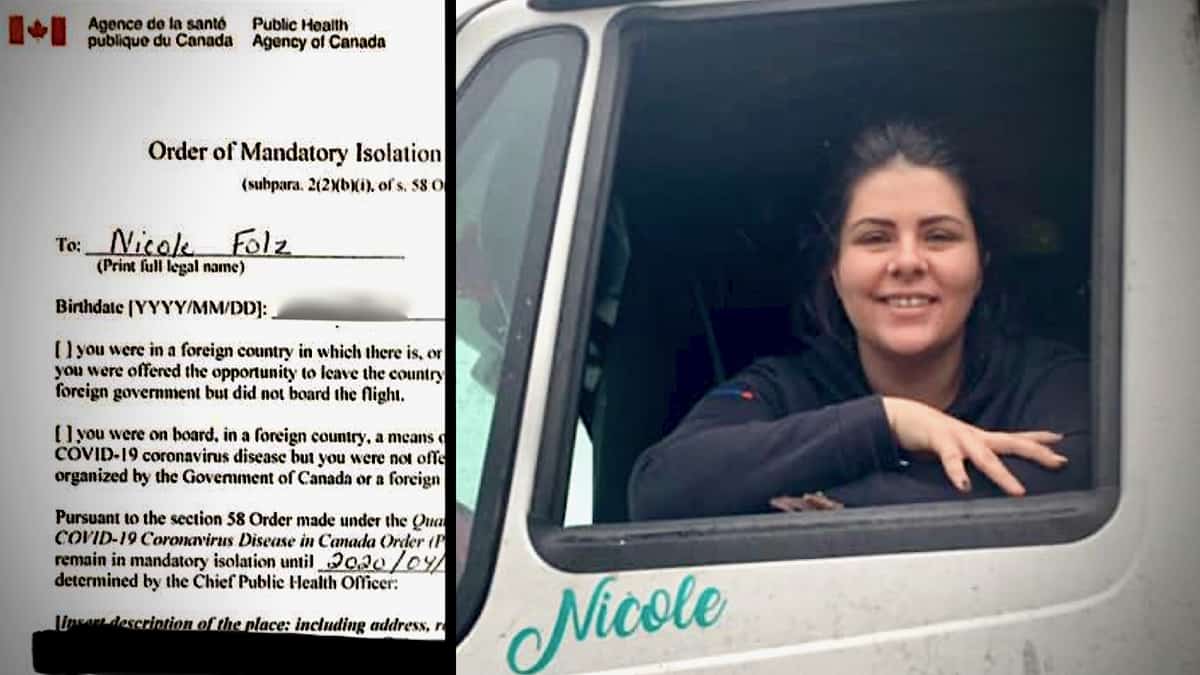
Folz began suspecting she had COVID-19 as she prepared to make her final less-than-truckload delivery in South Carolina, some 14 hours from home in Ontario.
The sore throat and dry cough she noticed after she crossed into the U.S. had gotten worse. On April 8, she felt that she might have a fever. Breathing became harder, too. And she had lots of pain.
A thermometer she purchased on April 9 confirmed she had a fever of 101.3. By the time she blew a tire near Washington, Pennsylvania, on her backhaul, she had a fever of 102.2.
It got much worse from there. She required supplemental oxygen by the time she arrived at Etobicoke General Hospital in Toronto on April 10, after crossing the border and dropping off her tractor-trailer. Fluid had started to fill her lungs.
“I never felt that sick before in my entire life,” Folz told FreightWaves from a hotel serving as a federal quarantine facility near Toronto as she recovers from COVID-19 infection. Public health nurses visit her regularly and the Red Cross provides meals.
After the onset of symptoms — that she thought were a cold — she made three deliveries, waited nearly 21 hours for a backhaul, and safely got her rig back to Canada while following public health protocols upon her return.
Folz is among the thousands of truck drivers who continue to move freight between Canada and the U.S. during the COVID-19 pandemic. No amount of personal protective equipment and precautions can eliminate the risk of infection or how and when it might hit.
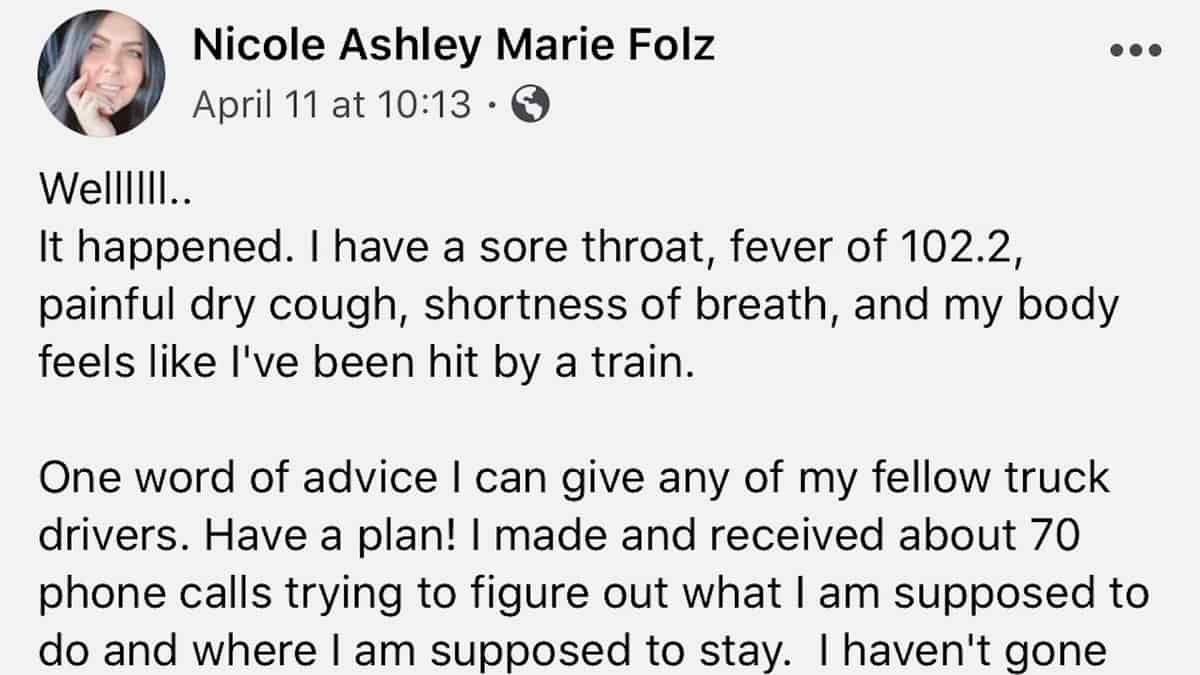
“One word of advice I can give any of my fellow truck drivers: Have a plan!” Folz wrote in a 600-word Facebook post that chronicles her experience. More than 17,000 people have shared it. (“It went viral,” Folz joked.)
Folz’s experience also offers a cautionary tale for truck drivers and carriers: Make sure everyone is on the same page.
“I want other drivers to have that conversation — be proactive — and ask the company, if I fall sick on the road, what should I do?”
Folz, like many drivers, had been keenly aware that the job exposed her to greater risk for COVID-19.
Her previous LTL run involved stops in Detroit and Chicago, areas with far more severe outbreaks. Folz had been sleeping in her truck during her returns to Canada to avoid exposing her father, who lives with her.
“It probably goes without saying, but it takes a lot of confidence to get into a truck and go across the border,” said Shawn Backle, operations manager at Folz’s carrier, Ontario-based Transport N Service.
The onset of symptoms suggest she may have gotten COVID-19 while picking up medical supplies in Chicago a week earlier, Folz said.
Messages to carrier ‘a clear cry for help’
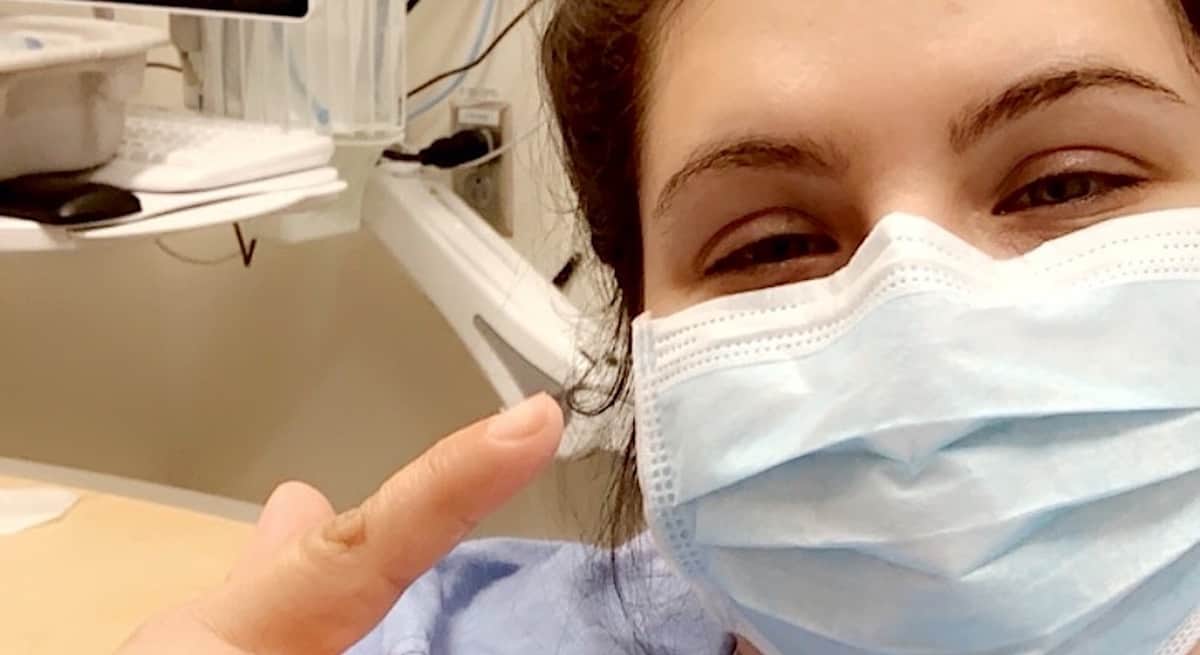
Folz powered through as her symptoms worsened. She delivered her final load wearing gloves and a face shield, and slathering on copious amounts of hand sanitizer. She then waited nearly 21 hours for her backhaul.
“I did my due diligence while protecting the health of others and myself,” Folz said.
Missing was a plan for getting Folz home despite messages and calls to her carrier and conversations with public health nurses in Canada.
“I thought my messages were a clear cry for help,” she said.
Backle said the company is reviewing its internal procedures and that clearly there was a breakdown in communications during Folz’s trip.
“It’s saddening for this to have happened,” Backle said. “I wish we had had all the information about her situation. The help is here. The sad part with Nicole is we didn’t realize that she required help after it appeared that she had it already. There was a disconnect.”
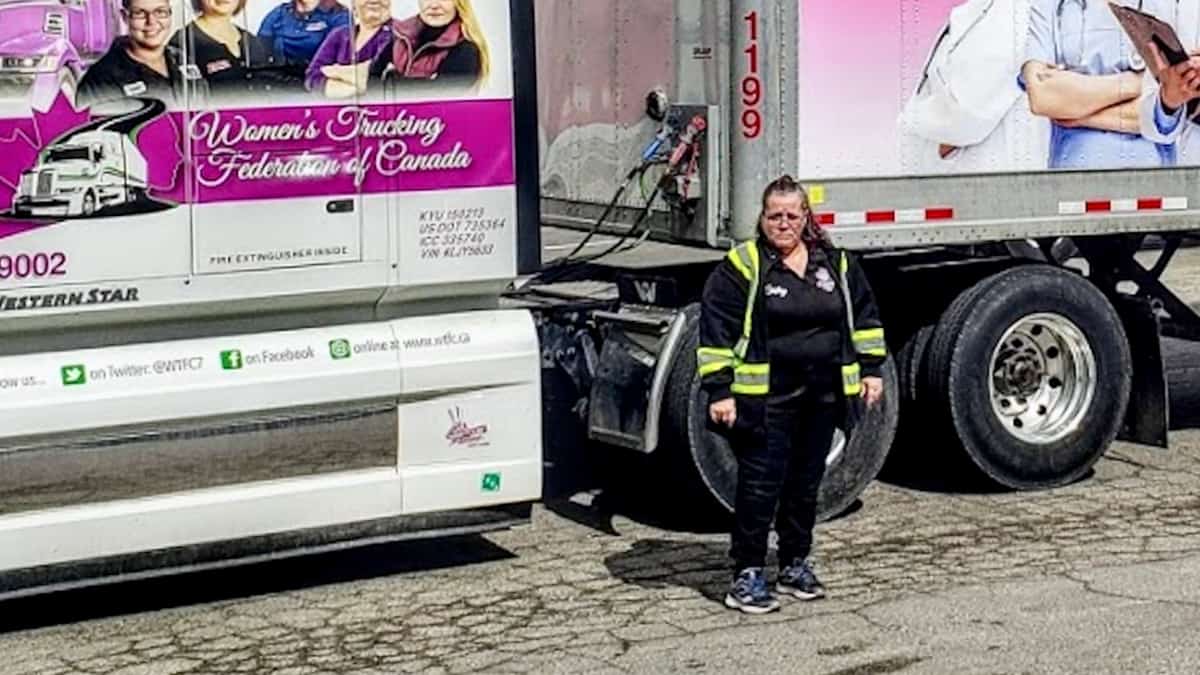
A clear plan of action only emerged after Folz reached out to another truck driver, Shelley Uvanile-Hesch, who also runs the Women’s Trucking Federation of Canada.
Uvanile-Hesch began raising the alarm with federal and provincial officials, including Ontario Premier Doug Ford. Soon, calls started coming from officials at Transport Canada, the Canada Border Services Agency and the Public Health Agency of Canada.
A well-coordinated effort subsequently took place to preclear Folz’s freight. She showed her passport against the window for the CBSA officer and proceeded to drop off her tractor-trailer.
From there, she drove her car straight to the federal quarantine facility. Going home would have been too risky for her father.
Ultimately, Backle said he is proud of Folz.
“I applaud her for how she handled this,” he said.
Asked how carriers and drivers should respond if a driver gets ill on the road, a spokesperson for Transport Canada pointed to a set of guidelines it released earlier in April, addressing commercial vehicle operations and COVID-19.
“The document builds on the latest guidance developed by the Public Health Agency of Canada and the Canada Border Services Agency, and other recognized public health authorities,” Transport Canada spokesperson Simon Rivet told FreightWaves in an email.
“It offers public health information, as well as tips on disinfection, hand-washing, and self-monitoring to limit the spread of COVID-19.”
But the guidelines do not lay out a clear protocol for a situation like the one Folz faced.
Doctor calls for more testing of drivers
Dr. Johnathan Davids, the medical director of DriverCheck, a leading provider of drug and alcohol testing and occupational health services for Canadian trucking companies, told FreightWaves that COVID-19 is forcing difficult choices upon carriers and drivers.
“It’s all about managing risk,” he said.
Davids said he would like to see more testing for cross-border drivers, particularly as rapid and reliable test kits become available.
“If we had more widespread testing, we’d probably be better off,” Davids said. “If you have a good, objective test to know in 15-45 minutes if this person is actually clear, you can sequester and prevent widespread infections.”
It also would potentially identify asymptomatic cases before drivers hit the road.
‘I still love this job’
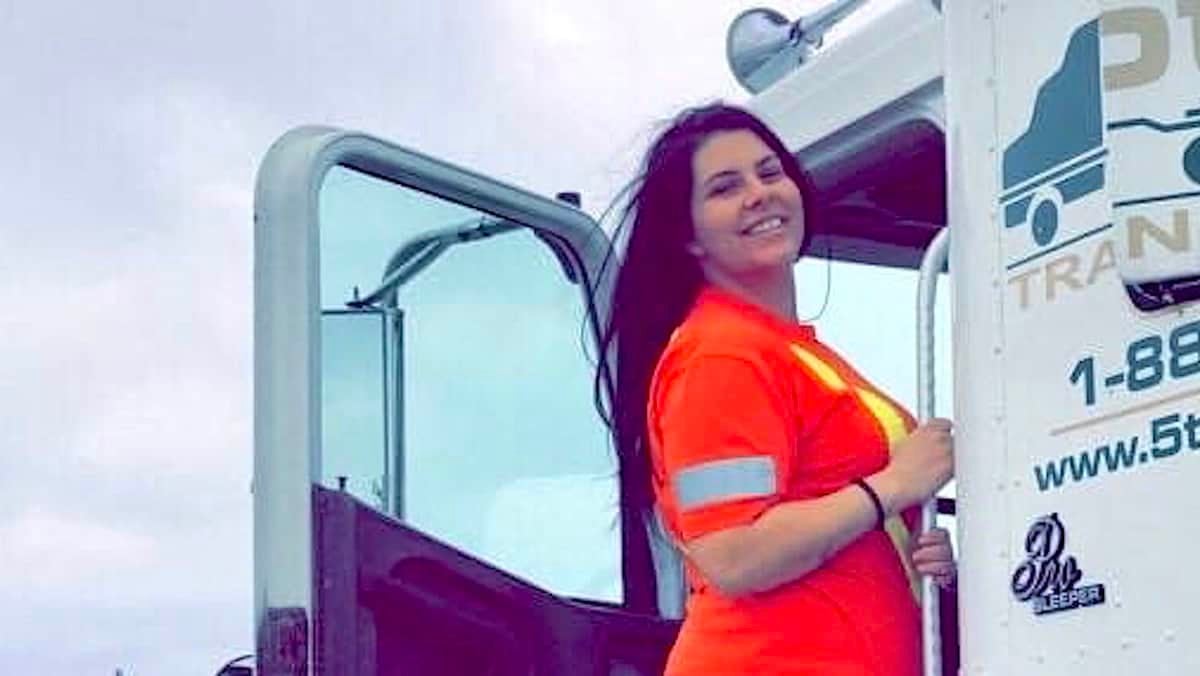
Folz has been a truck driver for only about a year. She lost her first job at Hyndman Transport in December after its corporate parent, Celadon Group, shut Hyndman down as Celadon filed for bankruptcy.
Folz plans to get back on the road after her quarantine ends — though after taking an additional week to recover.
“I still love this job,” she said.
In the meantime, she applied to receive a C$2,000 emergency monthly benefit from the federal government — less than half what she’d earn while driving.
“That barely covers my bills,” she said.
Editor’s note: This story has been updated to reflect new information from Folz. She confirmed she had a fever on April 9, rather than April 8 as originally reported. She also waited 20.5 hours for her backhaul, rather than 21 hours as first reported.












surgical gloves wholesale suppliers
Such a nice blog on covid-19 diagnosis and I hope you keep update us with such great tips and information in future too. This is a great post; I will share as much as I can. Thanks for creating awareness in people.
Stephen Webster
This disease is very bad. A cousin of mine Lost a good friend and coworker to C 19. The coworker was 52 and thought he was over the. C 19. He died at home in bed unable to call for help or breathe. His wife and another family member has C 19 despite taking precautions. A homeless friend of mine went to hospital over 5 weeks ago in Toronto Ontario. He was sent back out on the street. He gave C 19 to at least 20 more homeless and 2 volunteers. He was not tested and showed no signs of C 19. He has since expired. Not all truck drivers with C 19 are lucky enough to be able to drive back to Canada. Some truck drivers have parked and died in the truck . The Government and the trucking industry need to do more to get truck drivers safety to treatment. The W H O information was different than the information coming out of Hong Kong or Jewish intelligence. Many people with connections to Hong Kong were busy buying masks before January 15. of 2020. from Mexico.
Lil 🚬
Freight waves story on COVID effecting drivers is concerning. The exposure drivers allow themselves to be on is a issue to be discussed. Much like the 500k Guaranteed Reward being offered by billionaire J.B. Hunt Transportation heir Towery “Tyree” M Burris-Hunt. The successor heir grandson of Johnny Bryan Hunt went missing in late 2014. Reportedly in Cleveland County NC after traveling from Arkansas. The Heir which used the nickname J.B. Hunt jr is said to have been detained in a Gaston County home. He is offering the reward for info leading to arrest of identity thief using his name & likeness and that of J.B. Hunt.